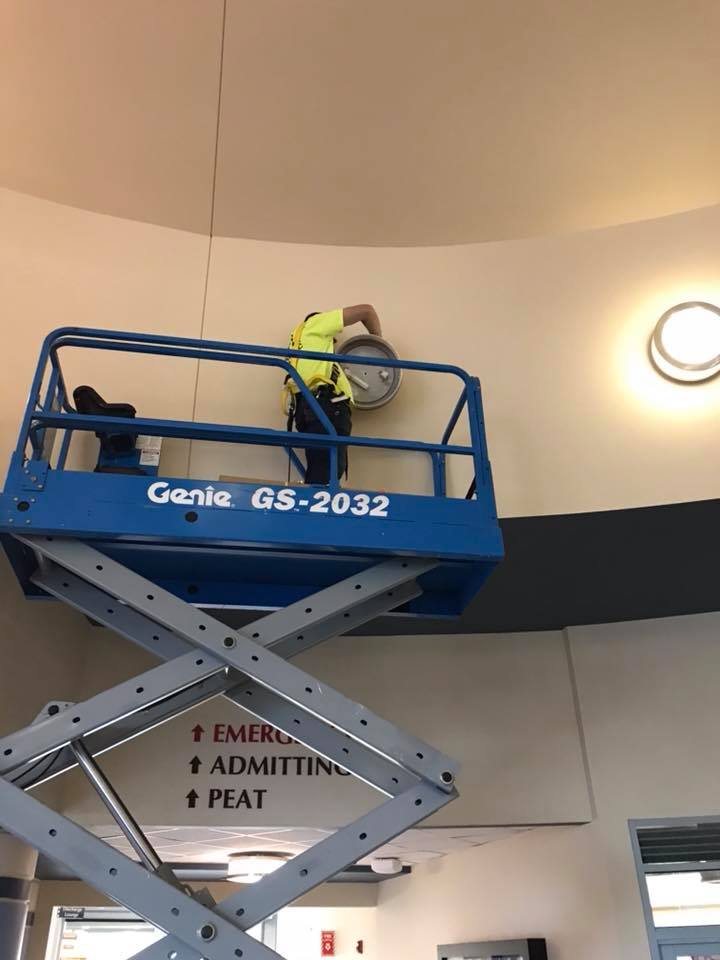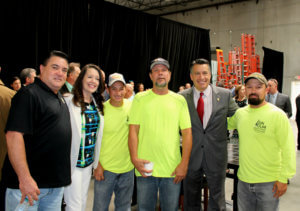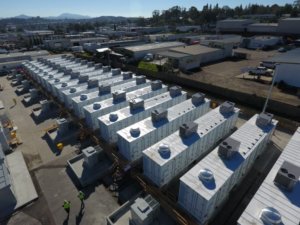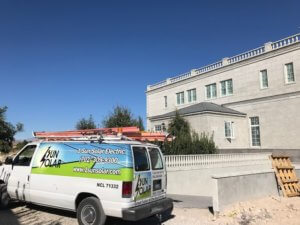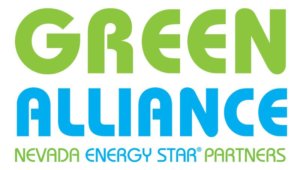
Fight for rooftop solar
Near the end of 2005, Louise Helton had one of those life-changing moments that usually only happen in Hollywood movies. Friends had invited her to join Nevada movers and shakers in an ostentatiously decorated Las Vegas casino ballroom to hear former President Bill Clinton speak. He challenged the audience to diversify the state’s economy, and to do so in a very specific way. Adopting a Southern drawl, Helton recalls the words that inspired her: “And he said, ‘If I were y’all, y’all would be the Saudi Arabia of solar.’ ”
Clinton’s pitch made sense to the 51-year-old Helton. With its abundant sunshine, Nevada was well positioned to become a clean energy leader. Besides, the state lacks its own coal or natural gas reserves, so it has to import those conventional fuels, thus benefiting other states’ economies instead of its own. “There is no better or cheaper resource than the sun that is shining down on the sunniest place in the West,” Helton says.
Clinton’s words percolated away inside Helton for a few years. Then, in 2008, she took the leap. Using savings from the two decades she spent working with at-risk kids, she opened her own company, 1 Sun Solar Electric. She kept costs down by melding it with her life partner’s successful tile and stone company, and in 2009, they started attaching solar panels to roofs in Las Vegas. Her timing was unfortunate; the recession hit Las Vegas especially hard and the impacts lingered, but Helton was able to keep her small crew working and her business in the black. By the time Nevada’s economy bounced back in 2014, the cost of solar panels had plummeted. Helton’s company was ready to ride the wave. “We were making a very good living and supporting a crew of folks who were able to support their families,” she recalls.
Her business relied on a state law that required the monopoly electricity provider, NV Energy, to pay customers for power generated by their solar panels. For each unit of energy provided to the grid, NV Energy would give them a free unit. This one-to-one swap, called net metering, kept solar customers’ bills low and reduced the time it took to recoup their upfront investments.

Big companies that lease solar panels, such as SolarCity and Sunrun, swooped into Nevada, hiring hundreds of people. In 2015, a record 24,564 people applied to be solar customers with NV Energy, according to the company. But near the end of that year, the Public Utility Commission of Nevada, the state’s utility regulators, crushed the nascent solar boom by increasing fees for solar customers and slashing reimbursements for the power they feed into the grid. That fundamentally altered the economics of rooftop solar. “It was stunning,” Helton recalls. “That’s how we found ourselves upside-down and backwards and almost out of business.”
The Nevada regulators’ order was the most extreme example of a nationwide effort by corporate utilities — panicked about losing market share and profits — to roll back net-metering policies. It’s backed by the deep pockets of fossil fuel industrialists like the Koch brothers, conservative lobbying groups like ALEC, the American Legislative Exchange Council, and the electricity industry’s own trade group, the Edison Electric Institute. But the Nevada regulators unexpectedly sparked a fierce resistance movement, comprised not only of environmentalists and clean-energy advocates, but also libertarians, small-business owners like Helton, and ordinary citizens who have installed rooftop panels or thought about doing so. It’s not just a battle between dirty and clean energy; it involves corporate profits, individual freedom and the appropriate role of government in incentivizing market shifts. And if the ultimate outcome in Nevada is any indication, the utilities have a tough fight ahead of them.
Nevada’s net-metering rules were first implemented back in 1997, when rooftop solar panels were still a novelty. They required the state’s investor-owned utility, NV Energy, to buy the electricity generated by customers’ solar panels at the retail rate. Still, the high cost of panels combined with the low cost of electricity in Nevada made rooftop solar economically unattractive, even with net metering, rebates and other incentives. For a decade or more, few rooftops in the state sported panels.
It finally took off around 2013. Prices had fallen enough that most customers could recoup their upfront investments in 10 years or less. And companies had started offering to lease solar panels to homeowners, making solar affordable for people without the $20,000 or so needed to buy their own panels. Like other utilities around the country, NV Energy was supportive of rooftop solar while it was rare. But as soon as its popularity rose, the utility started pushing the Legislature to dial back the incentives.
“Solar growth is happening extremely rapidly across the country, and it’s probably going to speed up. That’s making utilities very nervous, especially in sunny places,” says Lincoln Davies, a professor at the University of Utah’s Quinney College of Law. “The change in Nevada was part of a larger trend of utilities starting to push back.”
The terracotta rooftops on Helton’s street in southwest Las Vegas tell the story of the boom. Hers used to be the only house with solar panels, but starting a few years ago, several neighbors followed her example. Skip Spreitzer, 66, leased his solar array for 20 years through SolarCity. He wanted to do his part to protect his grandchildren’s future by reducing the greenhouse gas emissions that come from burning coal and natural gas. And, as a retiree, he was drawn to the idea that the solar panels would be a hedge against higher utility bills in the future, should natural gas prices spike.
During the daytime, when the sun shines, the photovoltaic panels perched on Spreitzer’s roof generate power for his lights and appliances. And when they generate more than he needs, the excess flows onto the grid to be used by nearby homes. Spreitzer relies on the grid at night and during the long hot days of summer, when air-conditioning sucks more juice than his panels can generate.
According to a 2014 study, an NV Energy rooftop solar customer could save on average just over $1,000 per year. For Spreitzer, those savings were mostly offset by his monthly solar panel lease payments. But down the street, Helton’s bills dropped dramatically after she installed panels in 2010. She owns her own panels, uses LED lighting and efficient appliances and heats with gas. Over the course of the year, her panels produce about the same amount of energy she consumes, so she basically just pays NV Energy service fees. Helton paid $28,000 seven years ago for those panels, about twice today’s cost.
These improving economics helped Nevada rooftop solar grow eightfold between 2014 and 2016, following a larger trend. Nationwide, electricity generation by homeowners and small businesses nearly doubled over that time, according to the federal Energy Information Administration, and total solar installations in the U.S. are expected to hit 2 million next year.
Meanwhile, public support for rooftop solar is broadening, even among people who don’t plan to use it themselves. “People like solar. It appeals to everyone from libertarians to the far left. The beauty of solar, particularly rooftop solar, is it doesn’t have a single narrative that’s driving it,” says Shelly Welton, an assistant law professor at the University of South Carolina, who tracks renewable energy policies around the country. Some people like it because it saves money, others because it helps fight climate change. Many simply enjoy being self-sufficient.
In part because of the promise of clean energy jobs and the growing political heft of the solar industry, politicians of both parties promote renewable power. In 2013, Nevada Gov. Brian Sandoval, a Republican, courted clean energy businesses, offering huge financial incentives to lure companies — like SolarCity and Tesla (now one company) — to the state. When a new SolarCity training center opened in West Las Vegas, just a month prior to the PUC’s fateful net-metering decision, Sandoval said it would make the state “the regional hub for training workers in the jobs of the 21st century. Our homegrown solar industry has already created over 6,000 good Nevada jobs, and has tremendous potential to continue driving innovation, economic diversification and opportunity in the Silver State.” SolarCity expected to train 4,000 solar workers a year at the facility.
Meanwhile, utilities and fossil fuel interests like the Koch brothers were already sounding the alarm about the threat rooftop solar poses to their profits. In 2013, electric utilities’ main trade group, the Edison Electric Institute, published “Disruptive Challenges.” The report warns that rooftop solar, batteries and other technologies could “directly threaten the centralized utility model.”
Utilities sell a product, electricity. If their customers start generating their own electricity, the utilities sell less product and make less money. To keep profit margins up, they have to increase electricity prices — inadvertently chasing even more customers to solar. That creates a feedback loop, or what Edison Electric Institute calls a “death spiral.” The phrase is “hyperbolic,” says Davies, but “utilities are right to worry about that. The price of solar keeps dropping. Utilities are risk-averse. When they see a risk, they get nervous.”
Publicly, instead of complaining about lower profits, utilities argue that solar power shifts energy costs to the customers without solar, thereby hurting low-income people. Utilities spread the costs of maintaining the grid across their entire customer base, and with fewer people paying sizeable bills, non-solar customers end up having to pick up more than their share of the grid costs.
Many studies have tried to suss out the costs and benefits of rooftop solar and net metering. Most show that it provides a net benefit, especially if only a small portion of a utility’s customers have solar. Collectively, a bunch of residential solar panels functions like a large-scale solar farm, offsetting the need for utilities to construct new power plants or install expensive pollution-control equipment on coal-fired power plants. Utilities also save money they’d otherwise pay for coal or natural gas. And, because the electricity is used by homeowners or their neighbors, rooftop solar eliminates the expensive problem of electricity being lost as it flows long distances on power lines.
Still, utilities, even the ones that support renewables, feel like they’re getting a raw deal. They have to pay full retail price for solar generated on homeowners’ rooftops, when they could save money for themselves and their non-solar customers by getting power from their own conventional or renewable power plants or buying it wholesale from other providers. Wholesale solar prices have dropped considerably, increasing the gap between what utilities pay for rooftop and wholesale solar. The bigger the spread, the more money they — and therefore their non-solar customers — are losing. Plus, rooftop solar doesn’t help electric companies when they need it most. Solar starts to fade during the peak hours of energy demand, in the late afternoon and evening during summer, when people get home and crank up their air conditioners. Companies still have to buy expensive power to meet that demand.
And so, many utilities have gone on the offensive, trying to shrink or kill net-metering policies. In California and Colorado, regulators balked and largely protected solar customers from higher rates. Arizona Public Service, the state’s largest utility, spent heavily in the 2014 elections to oust solar-friendly members of the Arizona Corporation Commission, which regulates utilities. The Salt River Project — which as a quasi-municipality is not under the jurisdiction of the Arizona Corporation Commission — adopted higher rates for its new solar customers. In Utah, Rocky Mountain Power, which like NV Energy is owned by Berkshire Hathaway, is now trying to boost electricity bills for solar customers.
Since the public backlash was unleashed in Nevada, NV Energy has tried to stay above the fray, at least publicly — the company refused repeated requests for interviews for this story. But one of the strongest voices in opposition to pro-solar net-metering policies is longtime labor boss Danny Thompson, who recently retired from the Nevada AFL-CIO and now works as an independent lobbyist for the International Brotherhood of Electrical Workers, which represents hundreds of NV Energy employees. A former state legislator, Thompson says he used to be a big supporter of solar. But he objects to the business model of companies like SolarCity and Sunrun, which lease their panels to customers and finance the installations in part by selling federal tax credits to banks or other investors. It’s a good deal for the investors and the middle-class folks who lease the panels. But most low-income Nevadans can’t afford to buy or lease solar panels. “What I didn’t like was companies coming in and selling long-term leases so people don’t own their solar panels,” Thompson says. “The companies were taking the leases and monetizing them on Wall Street as investments. The net effect is you have poor people subsidizing everyone else.”
The union also objected to the fact that solar companies pay less than union wages, and their crews often have only one licensed electrician.
This was the kind of complaint about net metering Nevada lawmakers heard when the Legislature met for its 2015 session. Under Nevada law, the net-metering incentive would tap out once 3 percent of a utility’s electricity was produced by rooftop solar. Some solar companies were lobbying hard to increase that cap. NV Energy argued that with solar panel prices plummeting, the industry no longer needed net metering as an incentive.

So in June 2015, Nevada lawmakers ordered the Public Utility Commission to set new rates that would minimize cost-shifting to non-solar customers.
That summer and fall, the Public Utility Commission held a series of heated hearings in Carson City. Helton attended every session via video link from a commission building in Las Vegas. Pro-solar protesters, including Skip Spreitzer and, at times, hundreds of solar workers, demonstrated outside. It was all for naught. “We took in boxloads of postcards, and it didn’t seem to faze them at all,” Spreitzer says. “Those people sitting on the board just weren’t going to hear anything we had to say.”
The commission considered the additional costs of serving solar customers but not the benefits — job creation, popularity, reduced greenhouse gas emissions and a cleaner environment. It calculated that on average, the savings realized by each solar customer in southern Nevada would push NV Energy annually to shift $623 to all of the other customers. That increases each non-solar customer’s monthly bill by about $2.50, which the commission considered “unreasonable.”
That the commission then penalized new solar customers was no surprise, but the extent to which net-metering credits were cut, and the fact that they would also apply to existing solar customers, was shocking. “I was aghast. I thought, there’s no way they could do that,” Helton says.
Even Gov. Sandoval — along with other lawmakers who had directed the regulators to take up the issue — seemed unprepared for the utility commission’s order. Sandoval expressed concern about solar workers losing their jobs. But he also told a local television reporter from KTNV that he wasn’t picking sides and believed that the Public Utility Commission was “uniquely qualified” to make the call.
The consequences were swift and substantial. In 2016, NV Energy received only 287 applications for solar hookups, about 1 percent the number of the previous year. The big leasing companies pulled out of the state entirely. SolarCity’s training center shut down, companies closed warehouses and announced layoffs. An estimated 2,600 solar workers eventually lost jobs. Helton herself had to lay off two people, half of her crew. Her neighbor, Spreitzer, watched his electric bills shoot up and knew they would continue to do so. “I was real worried; I spent a lot of time down there at the Public Utility Commission office where we were having our protests,” Spreitzer says.

Helton was determined to ride out what she calls the “solar coaster,” and soon became a leader of the movement, in part because she’s articulate, outgoing and familiar with the workings of the state Legislature and governor’s office after years of lobbying for better laws for at-risk kids. Of the intense political wrangling, she says playfully: “President Clinton never mentioned that part.”
Thousands of others joined her in protest, prompted by more than just the loss of good jobs. Many people saw the order as infringing on their freedom to choose to produce their own electricity. Activists collected more than 115,000 signatures from voters — twice what they needed — to put a net-metering referendum on the ballot in November. (After a group backed by NV Energy challenged the referendum in court, the Nevada Supreme Court struck it down.)
The intense backlash forced Sandoval off the fence. In the first months of 2016, he made several moves that slowly reversed the commission’s order. He named a New Energy Industry Task Force, which included representatives from solar companies and environmental groups as well as NV Energy and Thompson, who represented the employees’ union. In May 2016, the group urged the Legislature to restore the original one-to-one reimbursement rates for existing customers. Four months later, it suggested temporarily restoring one-to-one rates for new solar customers, too, while also charging them at least $25 per month to ensure that they pay their share of grid costs. That same month, a Nevada judge ruled that the commission’s decision to revoke one-to-one net metering for customers who already had solar was a “denial of fairness and due process.”
Soon afterwards, the utility commission backtracked, approving an agreement between NV Energy and solar companies to restore net metering to existing solar customers like Helton and Spreitzer. Just days later, Sandoval replaced two members of the Public Utility Commission. In December, the commission temporarily restored net metering for new customers, but only for a limited number in northern Nevada. The commission’s new chairman, Joe Reynolds, explained the reversal by quoting Abraham Lincoln: “Bad promises are better broken than kept.”
Although net metering wasn’t on the November ballot, per se, it was prominent in voters’ and politicians’ minds in the months before the election. Even presidential candidates Bernie Sanders and Hillary Clinton weighed in. As Justin Watkins went door-to-door in his campaign to represent a middle- and upper-middle-class Las Vegas district in the state Assembly, he saw how potent the issue was. “We knocked on 30,000 doors. It was the number-two issue at the door, behind education,” Watkins recalls. A Democrat, Watkins says restoring rooftop solar is important to both Republicans and Democrats in his district. That may be why he won election in November. As one of his first major actions in office, Watkins sponsored a bill restoring favorable rates for solar customers.
Watkins partnered with Chris Brooks, another freshman assemblyman, who ran for office in part to restore rooftop solar. Brooks has owned and been an executive for companies that installed residential and large-scale solar projects. On the walls of his small office in the Legislature building hang photos of President Barack Obama visiting a couple of Brooks’ projects in the Nevada desert.
Soon after taking office, Brooks became a critical player in energy policy, chairing a key subcommittee that drafted much of the energy legislation. He also sponsored a bill requiring NV Energy to get a larger share of its power from renewable sources. He credits the public backlash to the PUC order with motivating legislators to take renewable energy seriously in the 2017 session — the first time lawmakers convened since the 2015 order. “I think they were mad that government, in their eyes, screwed this up for them and they wanted to fix it. I think it played a tremendous role in empowering us with the knowledge that our constituents really want this and need it,” Brooks says.

Nevada’s Legislature only meets every other year for four months. That meant that the 2017 session was its last chance to pass the rooftop solar bill reversing the PUC’s decision, along with a slew of other pro-renewable bills, before 2019. Early on, Helton was delighted to see solar getting so much attention from Watkins, Brooks and others: “I’m very hopeful that the future is going to bode well for sunshine in Nevada,” Helton said at the time. But as the weeks ticked down toward the end of the session and the rooftop solar bill hadn’t passed yet, the solar advocates got increasingly anxious. “It has been a constant source of stress and effort. We’ve lost so much sleep over it,” Helton says. With only two weeks to go, Vote Solar, an advocacy group, decided it was time to pull out all the stops and gather a group of Nevada solar business representatives to confront the lawmakers face-to-face.
In late May, Helton and her colleagues took a 6 a.m. flight to Reno and piled into cars headed for Carson City. Their mood was upbeat because the day before, the Assembly had passed the rooftop bill, 38 to 2. It was a huge victory, but the ultimate outcome was far from certain. The Senate was still a wild card.
Standing outside the legislative building in the morning sunshine, Helton was the only woman in the group of nine. Wearing a vibrant yellow cardigan over a black polo shirt with her company’s logo, she stood out among the sport coats and golf shirts. Jessica Scott from Vote Solar gave the group a pep talk: “We have overwhelming public support. Nevadans really want to see solar. They were devastated by the 2015 Public Utility Commission decision, and they have in every way possible communicated that they want Nevada to be a clean-energy leader. It’s just exciting because it’s people power, it really is.”
Fired up, the crew embarked on a journey around the Capitol grounds.
This trip was a matter of survival for the businesses they represented. “What you see before you are just the remnants that are left of our industry,” Helton told a state senator during their first meeting that day. “We’ve already been struggling for two years to … keep our companies together, just so we could live to fight another day. Two more years; we just won’t make it.”
The big event of the day was the Senate Energy Committee’s hearing on the rooftop solar bill. When the group of solar businesspeople filed in, Brooks, the freshman assemblyman, was on the hot seat. Brooks’ task was to convince the senators to move quickly to approve the rooftop solar bill. Later in the hearing, the businesspeople each had three minutes to summarize their companies’ precarious positions and beg the senators to pass the bill.
Rob Kowalczik, of Robco Electric, had to lay off 27 people after the commission’s 2015 decision. “We lost a million dollars in sales a month. It hurt,” Kowalczik told me earlier that day. “I’d really like to bring back my employees.”
Kowalczik was lobbying for the first time in his life. Helton, on the other hand, is an old hand at schmoozing with politicians, and it showed. Throughout the day, she bumped into acquaintances — lobbyists, staffers and legislators — passing out hugs and overflowing with compliments. But the lawmakers were less generous about offering guarantees that the vote would go their way.
When the group encountered Republican Sen. Joe Hardy in the hallway outside his office, he listed the many things he likes about rooftop solar, but warned he couldn’t vote in favor of the bill until he had data showing that non-solar customers were not subsidizing solar ones. Sen. Pat Spearman, a retired U.S. Army officer who became an ardent supporter of renewable energy because she believes that too many soldiers have died for oil, predicted that senators voting against the bill would pay for it during the next election cycle. “It may be difficult,” she added honestly. “I will do whatever I can to try to get the bills out that we can if possible. If not this time, certainly next time.”
That was not what Helton wanted to hear at the end of a hard day of lobbying.
Helton felt anxious as they headed back to Las Vegas. Had their message gotten through to enough senators? Would the bill pass? Or would NV Energy find a way to quietly derail it?

Although NV Energy’s public position on the bill was neutral, behind the scenes company officials were in frequent contact with Brooks, pushing to reduce the amount that solar customers would be compensated for the power they fed to the grid. “The bottom line is they just do not support customer generation,” Brooks said later. But they don’t want to broadcast that because “it’s a horribly unpopular position to take, to try to oppose customers having the choice to make their own renewable energy.”
As the Senate crafted its version of the bill, NV Energy proposed cutting the compensation outlined in the Assembly bill. And less than two weeks later, that proposal was included in the bill the Senate unanimously passed. It sets up a sliding scale for reimbursing solar customers. Those who sign up for net metering now get compensated at 95 percent of the retail rate. But if they wait a few years to get in on net metering, they may be compensated at 75 percent of the retail rate.
Even so, the bill, which the governor signed, was a huge victory for solar advocates. It establishes that Nevadans have the right to put solar panels on their roofs, connect to the grid, store power in batteries and not get charged extra fees. “It’s a landmark moment that they included something like that. It recognizes the right to participate in the energy democracy in this way,” says Davies. “The Nevada Legislature did exactly what politically responsive bodies are supposed to do; they listened to their electorate.”
Tesla and Sunrun announced they would reopen their businesses. Already Helton is fielding several calls a day from potential new customers. “Now we hope to have the opportunity to build this industry into the powerhouse it should be for our state,” she says.
Nevada’s solar saga has sent a strong message to utilities in other Western states: Even in the era of Trump, they must accommodate a growing residential solar industry or face the public’s ire. Fearing a repeat of Nevada’s experience, Arizona’s largest utility, APS, reached a settlement with solar companies in March. The rooftop solar companies say it will allow them to avoid what happened in Nevada and keep working in the state. Greg Bernosky, director of state regulation at APS, told High Country Newsthat the utility had been paying very close attention to Nevada: “We understand solar is a wildly popular resource.”
In Nevada, the public’s insistence on solar is ultimately what pushed politicians to bring back net metering, despite the resistance of powerful interest groups. Assemblyman Brooks hopes the public’s enthusiasm for rooftop solar will spread to other policies and help accelerate the shift to clean energy in Nevada and potentially across the West. “As a fourth-generation Nevada native, I see how transformative good energy policy could be in the state,” he says. “We can create jobs, clean energy jobs, without polluting the planet and do it with Nevada workers and American ingenuity and American products. That’s a win for me at every level.”
Correspondent Elizabeth Shogren writes HCN’s DC Dispatches from Washington.
Original article: http://www.hcn.org/issues/49.14/solar-energy-solar-eclipse-big-utilities-meet-their-match-in-solar-scuffle




 Previous Post
Previous Post Next Post
Next Post